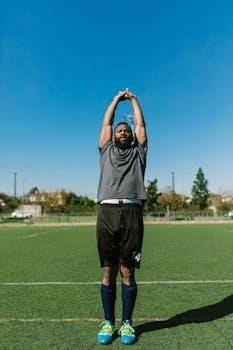D1 football workout programs are meticulously designed, blending strength, speed, and agility training for peak athletic performance. These programs incorporate evidence-based exercises and are tailored to the physical needs of football players. PDF resources often provide structured plans for athletes.
Understanding the Intensity of D1 Training
The intensity of D1 football training is exceptionally high, demanding rigorous dedication and physical prowess. These programs push athletes to their limits, requiring consistent effort and meticulous execution of each exercise. Unlike typical fitness routines, D1 training is geared towards developing elite-level strength, speed, and agility, necessary for competitive gameplay. Workouts are structured with a focus on maximizing performance, incorporating advanced techniques and demanding drills. These programs often involve extensive periods of training, pushing athletes beyond their comfort zone to achieve substantial gains. The level of intensity is not only physical but also mental, requiring athletes to be disciplined and focused. The demands of D1 training are designed to build not just athletes, but complete footballers. Understanding this intensity is crucial for anyone preparing to participate in such a high-level program, emphasizing the importance of a strategic and well-planned approach to training. The purpose is to forge resilient, powerful players prepared for the rigors of top-tier college football.

Key Components of a D1 Football Workout Program
Key components include strength training, speed and agility drills, and flexibility exercises. These elements are crucial for developing well-rounded, high-performing D1 football athletes. Nutrition also plays a pivotal role in performance.
Strength Training Focus
The strength training component of a D1 football workout program is meticulously structured, focusing on building raw power, muscular endurance, and overall physical resilience. It is not just about lifting heavy weights; it’s about targeted exercises that translate directly to on-field performance. Programs often incorporate a mix of compound lifts like squats, deadlifts, and bench presses, which engage multiple muscle groups simultaneously, enhancing overall strength and power. These exercises are fundamental for developing the explosive power needed for tackles, blocks, and sprints. Furthermore, the programs include variations and accessory exercises to address individual player needs and positions. For example, linemen might focus on exercises that improve pushing and pulling strength, while skill players might prioritize movements that enhance agility and explosive power. Proper form is emphasized to prevent injuries and maximize the benefits of each exercise. The training is progressive, meaning that the intensity and volume of training gradually increase over time to ensure continuous improvement and adaptation. This systematic approach ensures that athletes develop the necessary strength foundation to compete at the highest level of college football.
Speed and Agility Drills
Speed and agility drills are a crucial part of any D1 football workout program, focusing on enhancing a player’s quickness, change of direction, and overall explosiveness. These drills are not just about running fast in a straight line; they’re about developing the dynamic movement skills needed to excel in football. Programs often include a variety of drills such as shuttle runs, cone drills, and ladder drills, designed to improve footwork, reaction time, and lateral movement. These exercises help athletes develop the ability to quickly accelerate, decelerate, and change direction, which is essential for both offensive and defensive players. Furthermore, these drills focus on improving the athlete’s body control and coordination, reducing the risk of injuries and improving performance. Plyometric exercises such as box jumps and bounding are also incorporated to enhance explosive power and jumping ability. The drills are designed to mimic the movements needed on the field, ensuring the training translates directly to game situations. This training helps players become more elusive, allowing them to make key plays and evade opponents.
Flexibility and Mobility Exercises
Flexibility and mobility exercises are integral to a D1 football workout program, ensuring players maintain a full range of motion and reduce the risk of injury. These exercises go beyond simple stretching, focusing on joint health and muscle pliability. Dynamic stretches, such as leg swings and arm circles, are incorporated into warm-ups to prepare the body for intense training. Static stretches, held for longer durations, are used during cool-downs to improve flexibility and reduce muscle soreness. Mobility drills, targeting specific joints like hips, shoulders, and ankles, enhance movement quality and prevent limitations. Foam rolling is often used to release muscle tension and improve tissue quality. Programs emphasize the importance of consistent stretching and mobility work, making it a daily routine rather than an occasional activity. This commitment to flexibility and mobility is crucial for optimizing athletic performance, preventing injuries, and ensuring long-term career longevity. Proper flexibility and mobility enable athletes to execute complex movements with greater ease and efficiency on the field.

Specific Training Program Elements
D1 football training programs are structured with specific elements, including winter workouts and off-season strategies, to optimize player development. These regimens are designed to maximize athletic potential throughout the year.
Winter Workout Regimen
The winter workout regimen for D1 football programs is a crucial phase focused on building a strong foundation for the upcoming season. These programs, often available in PDF format, typically emphasize strength and conditioning, with a focus on foundational movements and exercises. This phase is designed to improve overall athletic ability, with specific attention given to power development and injury prevention. Winter workouts might include heavy lifting sessions, incorporating exercises like squats, deadlifts, and bench presses. Plyometric exercises can also be a key component, to enhance explosive power. Furthermore, these programs address mobility and flexibility, essential for injury prevention and improved performance. Conditioning drills, while not as intense as during the season, are also included to maintain a base level of fitness. The intensity and volume of training are often gradually increased throughout the winter months, preparing athletes for the more demanding off-season training. These workouts are meticulously planned to ensure that players are progressing safely and effectively.
Off-Season Training Strategies
Off-season training strategies in D1 football are designed to build upon the foundation laid during the winter months, with the goal of preparing athletes for the demands of the upcoming season. These strategies, often outlined in PDF workout programs, typically incorporate a mix of strength training, speed and agility drills, and position-specific exercises. The focus shifts from general conditioning to more sport-specific training, with an emphasis on power and explosiveness. Off-season programs often include a variety of plyometric exercises, such as box jumps and medicine ball throws, to enhance athletic capabilities. Speed and agility work may involve cone drills, shuttle runs, and other exercises designed to improve quickness and change of direction. Furthermore, these strategies prioritize injury prevention, through mobility and flexibility work. Nutrition and recovery are also vital components of off-season training plans, ensuring athletes are properly fueled and rested. The goal is to ensure that athletes enter the season at peak physical condition.

Resources and Materials
D1 football workout programs often utilize PDF documents containing detailed exercise plans, training schedules and nutritional guides. These resources are crucial for athletes to follow a structured approach to their training, ensuring optimal results and safety.
PDF Workout Program Examples
PDF workout program examples for D1 football often encompass a comprehensive approach to athletic development, detailing specific exercises, sets, reps, and rest periods. These documents are designed to be easily accessible and printable, providing athletes with a structured training plan they can follow consistently. Examples often include sections for warm-ups, strength training, speed and agility drills, and cool-downs, ensuring a well-rounded approach to fitness. Many programs also feature visual aids, like diagrams and pictures, to demonstrate proper form and technique. Some PDFs may be tailored to specific positions, accounting for different physical demands within the team. Furthermore, these resources can include sample training schedules for various parts of the year such as off-season, pre-season, and in-season, adapting to the athlete’s current goals. These programs are typically created by experienced strength and conditioning coaches, incorporating evidence-based training methodologies and scientific principles to maximize performance and reduce the risk of injury. The PDF format allows for easy distribution and storage, making it a convenient way for athletes to access their training program.
Importance of Nutrition
Nutrition plays a crucial role in the effectiveness of any D1 football workout program, acting as the fuel for athletic performance and recovery. A well-structured diet provides the necessary energy for intense training sessions and promotes muscle repair and growth. The correct balance of macronutrients—carbohydrates, proteins, and fats—is essential to optimize performance, as carbohydrates provide energy, proteins support muscle building, and fats are necessary for hormone regulation and overall health. Furthermore, proper hydration is vital to maintain energy levels and prevent dehydration, which can hinder performance. D1 football workout programs often integrate nutritional guidance, including recommended meal plans and supplement information. These plans typically emphasize whole, unprocessed foods, and they often specify the timing of meals and snacks around training. Consistent, high-quality nutrition enhances the benefits of workout programs, ensuring athletes achieve peak physical condition and minimize the risk of injury. A failure to prioritize nutrition can impede progress and hinder athletic potential, underlining the importance of integrating it into an athlete’s training regimen.

Additional Program Considerations
D1 programs often include recruit development, focusing on individual player growth. These programs integrate movement, coaching points, and overall athletic enhancement for each player. This ensures personalized training and progress.
Recruit Development Integration
Integrating recruit development within D1 football workout programs is crucial for the long-term success of any team. These programs are not just about immediate physical gains; they are about fostering a culture of continuous improvement and skill enhancement. A comprehensive recruit development strategy ensures that incoming players are not only physically prepared but also mentally and technically equipped to contribute at the D1 level. This involves a blend of on-field drills, strength and conditioning, and educational components. Coaches often use PDF workout program examples as a foundation, but they adapt these to meet the individual needs and skill levels of each recruit. The integration also includes consistent feedback, performance tracking, and personalized coaching points to help recruits reach their full potential. Furthermore, the process emphasizes the importance of nutrition and recovery, ensuring that recruits understand the holistic approach needed to succeed in D1 football. By focusing on a well-rounded development, programs aim to create not just talented players, but also well-prepared and disciplined athletes.

